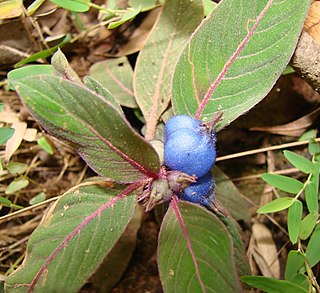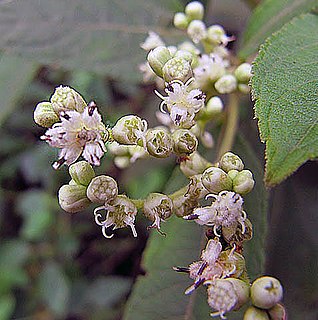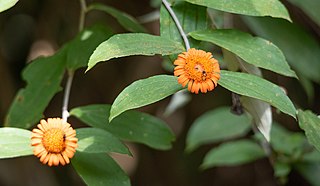| Critonia | |
|---|---|
 | |
| Critonia morifolia | |
| Scientific classification | |
| Kingdom: | Plantae |
| Clade: | Tracheophytes |
| Clade: | Angiosperms |
| Clade: | Eudicots |
| Clade: | Asterids |
| Order: | Asterales |
| Family: | Asteraceae |
| Subfamily: | Asteroideae |
| Supertribe: | Helianthodae |
| Tribe: | Eupatorieae |
| Genus: | Critonia P.Browne |
| Type species | |
| Critonia dalea | |
| Synonyms [1] | |
| |
Critonia is a genus of flowering plant in the subtribe Eupatorieae of the sunflower family. [2] [4] [5]
The most notable trait that characterizes the genus is the presence of pellucid punctations caused by internal secretory pockets of the leaves - to be seen these must be viewed with a hand lens while holding the leaf up to light in most species of the genus. Most species of Critonia also have smooth opposite leaves, a shrubby habit, unenlarged style bases, relatively few (3-5) flowers per head, and imbricate involucres. [6]
- Species
The genus is native to Mexico, Central America, South America, and the West Indies. [1]
- Critonia arachnoidea (Legname) R.M.King & H.Rob.
- Critonia aromatisans (DC.) R.M.King & H.Rob.
- Critonia bartlettii (B.L.Rob.) R.M.King & H.Rob.
- Critonia billbergiana (Beurl.) R.M.King & H.Rob.
- Critonia breedlovei R.M.King & H.Rob.
- Critonia campechensis (B.L.Rob.) R.M.King & H.Rob.
- Critonia conzattii (Greenm.) R.M.King & H.Rob.
- Critonia dalea (L.) DC.
- Critonia daleoides DC.
- Critonia dominicensis R.M.King & H.Rob.
- Critonia eggersii (Hieron.) R.M.King & H.Rob. - Ecuador [7]
- Critonia eriocarpa (B.L.Rob. & Greenm.) R.M.King & H.Rob.
- Critonia heathiae B.L.Turner
- Critonia hebebotrya DC.
- Critonia hemipteropoda (B.L.Rob.) R.M.King & H.Rob.
- Critonia heteroneura Ernst
- Critonia hospitalis (B.L.Rob.) R.M.King & H.Rob.
- Critonia iltisii R.M.King & H.Rob.
- Critonia imbricata Griseb.
- Critonia inaequidens (Urb.) R.M.King & H.Rob.
- Critonia lanicaulis (B.L.Rob.) R.M.King & H.Rob.
- Critonia laurifolia (B.L.Rob.) R.M.King & H.Rob.
- Critonia lozanoana (B.L.Rob.) R.M.King & H.Rob.
- Critonia macropoda DC.
- Critonia megaphylla (Baker) R.M.King & H.Rob.
- Critonia morifolia (Mill.) R.M.King & H.Rob. - Bolivia [8]
- Critonia naiguatensis (V.M.Badillo) R.M.King & H.Rob.
- Critonia nicaraguensis (B.L.Rob.) R.M.King & H.Rob.
- Critonia nubigenus (Benth.) R.M.King & H.Rob.
- Critonia paneroi B.L.Turner
- Critonia parviflora (Sw.) DC.
- Critonia peninsularis (Brandegee) R.M.King & H.Rob.
- Critonia platychaeta (Urb.) R.M.King & H.Rob.
- Critonia portoricensis (Urb.) Britton & P.Wilson
- Critonia pseudodalea DC.
- Critonia quadrangularis (DC.) R.M.King & H.Rob.
- Critonia sexangularis (Klatt) R.M.King & H.Rob.
- Critonia siltepecana (B.L.Turner) R.M.King & H.Rob.
- Critonia spinaciifolia (DC.) R.M.King & H.Rob.
- Critonia stigmatica (Urb. & Ekman) R.M.King & H.Rob.
- Critonia thyrsigera (Hieron.) R.M.King & H.Rob.
- Critonia thyrsoidea (Moc. ex DC.) R.M.King & H.Rob.
- Critonia tuxtiae R.M.King & H.Rob.
- Critonia wilburii R.M.King & H.Rob.
- Critonia yashanalensis (Whittem.) R.M.King & H.Rob.









